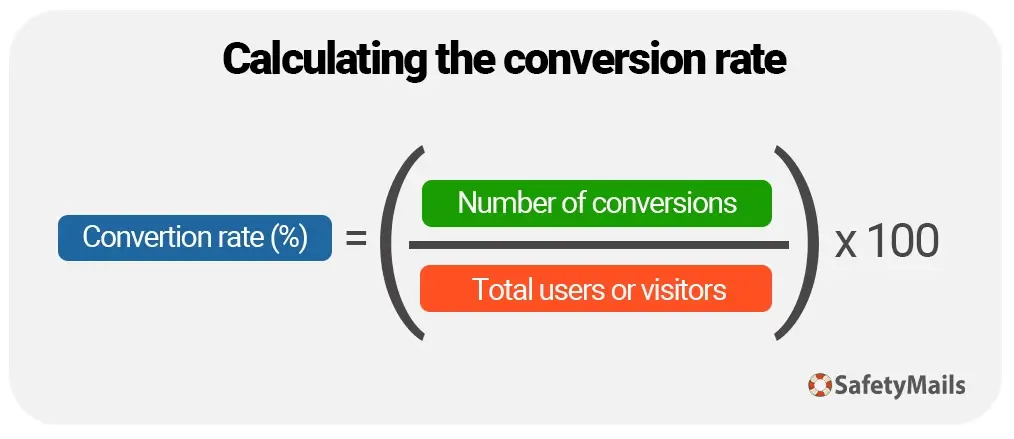Yes, email verification actively contributes to conversions, as it reduces the risk of being blocked due to bounces and promotes high-quality delivery, leading to an increase in a series of positive indicators related to engagement, such as the open rate and click-through rate, which are essential for conversion.
But what are the main factors that lead to conversion in email marketing? And what are the possible conversions? Also, how does taking care of email lists influence this metric?
Table of contents
Conversion rate: what is it and why is it important?
In general terms, conversion is the name given to when a user performs an action desired by the company. This action can vary according to the media and the campaign’s objectives, meaning that a lead or prospect advances through the stages towards the company’s final objective.
Types of conversion
Contrary to common belief, conversion is not limited to a financial goal, such as sales. There are several possible types of conversion, which can be grouped into direct and indirect conversions.
Indirect conversions (not financial)
Here, conversions are based on actions that do not involve financial exchange.
Some examples of conversions of this type are:
- Clicking on a link in an email (yes, click-through rate and conversion can get confused at some point). This can represent, for example, a visit to a blog post.
- Downloading material, such as an eBook, whitepaper, etc.
- Registering for events such as webinars or lectures.
- Creating a trial account.
- Signing up for a newsletter.
Direct conversions (financial)
In this case, the conversions are directly related to financial aspects. Examples include:
- The purchase of a product or service.
- Renewing a subscription or contract.
- Donations to charity campaigns.
Thus, conversion encompasses all the actions that move the lead or prospect forward in the sales funnel or relationship, leading to the achievement of the campaign’s objectives.
Key points for conversion in email marketing
When it comes to email marketing, we can identify several important conversion moments. The simple fact of clicking on an email can be considered a conversion, as can interaction on a landing page. Basically, there are three conversion moments which may or may not involve financial aspects:
- Call-to-action: clicking on a call-to-action link can be considered a conversion. For example: an email inviting recipients to read a piece of content on the blog. Everyone who clicks on the CTA and is directed to the article can be taken into account when calculating the conversion rate. Product purchases are also part of this category, as they involve clicking on purchase CTAs.
- Registrations: the action of registering for an event (free or paid) or for access to something (such as a SaaS platform, a course, streaming), also paid or free, can be considered a conversion.
- Downloads: any type of download of materials such as those mentioned above, such as research PDFs, whitepapers, eBooks.
This brings us to the conclusion that it is essential to optimize all stages of email marketing with a view to engaging the recipient and consequently converting them.
During the planning
The planning phase will determine all the steps in the following phases. That’s why it’s so important.
We won’t go into all the planning details, but it’s in this phase that you’ll determine the action’s conversion objective. So define it clearly (for example: “get 1,000 webinar registrations”).
During email production and sending
Ensure that your campaign is being sent by adopting the best email marketing practices, including the quality of the mailing lists and all the aspects of deliverability that are fundamental for messages to be delivered correctly.
First of all, create a layout that is clean, with organized visual elements that highlight the desired action, with clearly visible CTA buttons.
Still on the subject of Call to Action, remember to write clearly, objectively and creatively, with hyperlinks that lead directly to the next step.
Remember to create engaging and personalized subject lines that will attract the recipient’s attention in the inbox.
Landing Pages
When it comes to landing pages, remember that they should have the same visual style and message as the email, to reinforce communication and avoid mistakes.
Keep the layout clear and simple, avoiding distractions and focusing on the end goal.
How does email verification improve conversion rates?
The conversion rate is the result of a series of correct actions in the email marketing campaign. And among these actions, delivery and deliverability are fundamental! That is, delivering email messages to providers free of bounces, without suffering blocking actions and also being able to get these messages delivered to the inbox.
Any subsequent good practice in pursuit of conversion necessarily depends on this first aspect. Any failure here will lead to problems later on.
In this way, email verification is an indispensable step in the quest for quality email lists, bringing a series of benefits, such as:
- Reduction of bounces and blocks: contact lists without invalid email records, spamtraps, temporary addresses, among others, reduce the rates of hard bounces and soft bounces, helping to preserve IP and domain reputation. As a result, ISPs carry out fewer blocking and blacklisting actions.
- Increased deliverability: with proper behavior, free of bounces, email providers can ensure that more email messages are delivered to the inbox, contributing to greater engagement.
Thus, with fewer blocks and more emails being delivered to the inbox, the increase in engagement (open and click rates) will consequently lead to a higher conversion rate.
How to calculate the conversion rate
The conversion rate is calculated as the percentage of recipients or visitors who took an expected action in relation to the total number of people who had the opportunity to take that action. In general terms, the formula is:

So, for example, suppose you’ve defined that you want to publicize an online event and that your conversion will be calculated based on the number of registrants. You then send an email to 3,000 recipients, of which 1,000 click on the link and 50 convert, i.e. register for the event.
- Post-click conversion rate = (50 subscribers / 1,000 visitors) x 100 = 5%
If you want to calculate the overall conversion rate, i.e. taking into account the entire campaign contact list, simply replace the denominator in the equation:
- Global conversion rate = (50 subscribers / 3,000 emails sent) x 100 = 1.67%
Some recommendations:
- Define your goals clearly.
- Keep track of benchmarks in your market segment.
- Track your progress by comparing previous results.
- Use reliable tools and methods to evaluate changes in conversion rates.
Conclusion
The conversion rate is an important indicator of the success of email marketing campaigns, as it reflects the direct impact of the strategies and actions implemented. That’s why it’s essential to ensure an integrated approach, from planning to execution, including the creation of attractive content and optimized landing pages.
Email verification plays a key role in this process, eliminating barriers such as bounces and blocks, which damage deliverability and the sender’s reputation. With a clean and validated email list, messages are more likely to reach the recipients’ inbox, increasing the open rate, clicks and, consequently, conversions.
Therefore, investing in email verification and email marketing best practices is not just a precaution, but a strategy to maximize engagement and campaign results.
FAQ
What is conversion in email marketing?
Conversion in email marketing refers to any desired action taken by the recipient, such as clicking on links, downloading materials, registering for events or making purchases. It can be direct (financial) or indirect (non-financial).
Can email verification increase conversion rates?
Yes. Email verification helps messages reach the recipient’s inbox, reducing bounces and blocks. This increases open and click-through rates, creating more opportunities for conversions.
What is the difference between direct and indirect conversion?
Direct conversions are related to financial transactions, such as purchases or subscriptions. Indirect conversions involve actions that do not generate immediate revenue, such as clicks on links, downloads or subscriptions.
How does the quality of the mailing list influence conversion?
A clean mailing list with valid contacts increases deliverability, avoids blockages and improves engagement. This has a direct impact on all the metrics that lead to conversion, such as open and click-through rates.
How do you calculate the conversion rate of a campaign?
The conversion rate is calculated by dividing the number of conversions by the total number of recipients or visitors, multiplied by 100. Example: if 50 people register for an event after sending 3,000 emails, the overall conversion rate will be (50 / 3000) x 100 = 1.67%.



